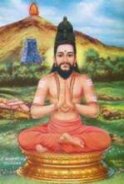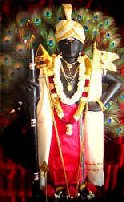

திரு அருணகிரிநாதர் அருளிய
திருப்புகழ்
Sri AruNagirinAthar's
Thiruppugazh

 |  திரு அருணகிரிநாதர் அருளிய Sri AruNagirinAthar's |  |
|---|
| திருப்புகழ் 762 மூல முண்டகனு பூதி (திருநல்லூர்) Thiruppugazh 762 mUlamuNdaganubUdhi (thirunallUr) |
 |  | தமிழிலும் ஆங்கிலத்திலும் பொருள் எழுதியது ஸ்ரீ கோபால சுந்தரம் Meanings in Tamil and English by Sri Gopala Sundaram | English in PDF PDF அமைப்பு | ஆலய வரிசை அகரவரிசை எண்வரிசை தேடல் venue list alphabetical numerical search |
|
தான தந்ததன தான தந்ததன தான தந்ததன தான தந்ததன தான தந்ததன தான தந்ததன ...... தந்ததான ......... பாடல் ......... மூல முண்டகனு பூதி மந்திரப ராப ரஞ்சுடர்கள் மூணு மண்டலஅ தார சந்திமுக மாறு மிந்த்ரதரு ...... வுந்தளாமேல் மூது ரம்பலவர் பீட மந்தமுமி லாத பந்தவொளி யாயி ரங்கிரண மூணு மிந்துவொளிர் சோதி விண்படிக ...... விந்துநாதம் ஓல மென்றுபல தாள சந்தமிடு சேவை கண்டமுதை வாரி யுண்டுலகி ரேழு கண்டுவிளை யாடி யிந்துகதி ...... ரங்கிசூலம் ஓடு மந்தகலி காலொ டுங்கநடு தூணில் தங்கவரி ஞான வண்கயிறு மீத ணைந்துசத கோடி சந்த்ரவொளி ...... சந்தியாதோ சூலி யந்தரிக பாலி சங்கரிபு ராரி யம்பரிகு மாரி யெண்குணசு வாமி பங்கிசிவ காம சுந்தரியு ...... கந்தசேயே சூர சங்கரகு மார இந்திரச காய அன்பருப கார சுந்தரகு காஎ னுஞ்சுருதி யோல மொன்றநட ...... னங்கொள்வேலா சீல வெண்பொடியி டாத வெஞ்சமணர் மாள வெங்கழுவி லேறு மென்றுபொடி நீறி டுங்கமல பாணி சந்த்ரமுக ...... கந்தவேளே தேவ ரம்பையமு தீண மங்கைதரு மான ணைந்தபுய தீர சங்கரதி யாகர் வந்துறைந லூர மர்ந்துவளர் ...... தம்பிரானே. ......... சொல் விளக்கம் ......... மூல முண்டகம் அனுபூதி மந்திர பராபரம் சுடர்கள் மூணு மண்டல (ஆ)தார சந்தி முகம் ஆறும் இந்த்ர தருவும் தளாமேல் ... மூலாதார கமலத்தில் உள்ள அனுபவ ஞானத்தைத் தரும் மந்திரம் மேல் நிலையில் உள்ள (சூரிய, சந்திர, அக்கினி எனப்படும்) முச்சுடர்கள், மூன்று மண்டலங்கள், ஆதாரங்களாக சந்திக்கப்படும் ஆறு ஆதாரங்கள்*, கற்பக விருக்ஷம் (போல விரும்பிய எல்லாம் அளிக்க வல்ல மேலைச் சிவ வீதி இவைகளை எல்லாம்) தாண்டி அவைகளின் மேல் சென்று, மூதுர அம்பலவர் பீடம் அந்தமும் இலாத பந்த ஒளி ஆயிரம் கிரண மூணும் இந்து ஒளிர் சோதி விண் படிக விந்து நாதம் ஓலம் என்று பல தாள சந்தம் இடு சேவை கண்டு அமுதை வாரி உண்டு ... பழைய (எல்லா தத்துவங்களும் ஒடுங்கும் பரவொளிப்) பீடமாகிய லலாட மண்டபத்தில், முடிவில்லாத திரண்ட ஒளியாய் விளங்கும், ஆயிரம் கிரணங்கள் வீசும் மூன்றாம் பிறை நிலவின் வடிவைக் கொண்ட ஆக்ஞை ஆதாரத்தில், சந்திர ஒளியுடன் கூடி மேல் நிலையில் பளிங்கு போல் விளங்கும் விந்து சம்பந்த (சிவசக்தி ஐக்கிய) நாத ஒலி அபயம் என்று அழைத்தல் போன்ற ஒலியுடன் பல வகையான தாளங்கள் சந்தங்கள் கலக்கும் நடன தரிசனத்தைக் கண்டு தேவாம்ருத கடலைப் பருகி, உலகு ஈர் ஏழு கண்டு விளையாடி இந்து கதிர் அங்கி சூலம் ஓடும் அந்த கலிகால் ஒடுங்க நடு தூணில் தங்க வரி ஞான வண் கயிறு மீது அணைந்து சத கோடி சந்திர ஒளி சந்தியாதோ ... பதினாலு உலகங்களையும் அங்கே விளக்கமுறத் தரிசித்து அனுபவித்து, சந்திரன், சூரியன், அக்கினி (இடைகலை, பிங்கலை, சுழுமுனை என்னும்) மூன்று நாடிகளின் வழியே சூலம் போல ஓடுகின்ற அந்தப் பிராண வாயு ஒடுங்க, (வீணா தண்டம் என்னும்) முதுகு எலும்பில் தங்கி, ஞான வளப்பம் பொருந்திய சுழு முனைக் கயிற்றின் வழியே மேலே தழுவி, நூறு கோடி சந்திரர்களின் ஒளியை (சிவப் பேரொளியைச்) சந்திக்கும் பாக்கியம் எனக்குக் கிட்டுமோ? சூலி அந்தரி கபாலி சங்கரி புராரி அம்பரி குமாரி எண் குண சுவாமி பங்கி சிவகாமி சுந்தரி உகந்த சேயே ... சூலாயுதத்தை ஏந்தியவள், பராகாச வடிவை உடையவள், கபாலம் ஏந்திய சங்கரி, திரிபுரம் எரித்தவள், திரி புரம் எரித்த போது அம்பாக இருந்த வைஷ்ணவி, என்றும் இளையவள், எட்டு** குணத்தினரான சிவபெருமான் பாகத்தில் உறைபவள் ஆகிய சிவகாம சுந்தரி மகிழும் குழந்தையே, சூர சங்கர குமார இந்திர சகாய அன்பர் உபகாரி சுந்தர குகா எனும் சுருதி ஓலம் ஒன்ற நடனம் கொள் வேலா ... சூரனை அழித்த குமார வேளே, இந்திரனுக்கு உதவி செய்தவனே, அடியார்களுக்கு உபகாரம் செய்தவனே, அழகனே, குகனே என்றெல்லாம் வேதங்கள் முறையிட்டு உரைக்க நடனம் செய்த வேலனே, சீல வெண் பொடி இடாத வெம் சமணர் மாள வெம் கழுவில் ஏறும் என்று பொடி நீறு இடும் கமல பாணி சந்திர முக கந்த வேளே ... பரிசுத்தமான திருவெண்ணீற்றை அணியாதவர்களும் கொடியவர்களும் ஆகிய சமணர்கள் இறக்கும்படி கொடிய கழுமரத்தில் ஏறுங்கள் என்று (திருஞானசம்பந்தராக வந்து) திருவிளையாடல் இயற்றி திருநீற்றை (கூன் பாண்டியனுக்கும், அடியார்களுக்கும்) அளித்த தாமரைக் கையனே, சந்திரன் போன்ற (ஆறு) முகமுடைய கந்த வேளே, தேவ ரம்பை அமுது ஈண மங்கை தரு மான் அணைந்த புய தீர சங்கர தியாகர் வந்து உறை ந(ல்)லூர் அமர்ந்து வளர் தம்பிரானே. ... தேவ லோகத்து ரம்பை போன்றவளும் பாற் கடல் அமுதத்துடன் தோன்றியவளும் ஆகிய லக்ஷ்மிதேவி அளித்த மானாகிய வள்ளி (அமுதவல்லி) அணைந்த திருப் புயத்தை உடையவனே, தீரனே, சங்கரத் தியாகர் என்னும் நாமம் உடைய சிவ பெருமான் வந்து எழுந்தருளிய திரு நல்லூர்*** என்னும் தலத்தில் பொருந்தி வீற்றிருக்கின்ற தம்பிரானே. |
* இங்கு சிவயோக முறைகள் விளக்கப்பட்டுள்ளன. அதன் சுருக்கம் வருமாறு: நாம் உள்ளுக்கு இழுக்கும் காற்றுக்குப் 'பூரகம்' என்றும், வெளிவிடும் காற்றுக்கு 'ரேசகம்' என்றும் பெயர். உள்ளே நிறுத்திவைக்கப்படும் காற்றுக்கு 'கும்பகம்' என்று பெயர். உட் கொள்ளும் பிராணவாயு உடலில் குறிப்பிட்ட 'ஆதாரங்கள்' (நிலைகள், சக்கரங்கள்) மூலமாகப் படிப்படியாகப் பரவி, மேல் நோக்கிச் சென்று, தலையில் 'பிரம கபால'த்தில் உள்ள 'ஸஹஸ்ராரம்' (பிந்து சக்கரம்) என்ற சக்கரத்துக்குச் செல்லும். இந்த ஐக்கியம் ஏற்படும்போது, அமுத சக்தி பிறந்து, ஆறு ஆதாரங்களுக்கும் ஊட்டப்பட்டு, மீண்டும் அதே வழியில் 'மூலாதார'த்தை வந்து அடையும். இந்த ஆதாரங்களை ஒழுங்கு படுத்தும் வகையில் மூன்று 'மண்டல'ங்களும் (அக்கினி, ஆதித்த, சந்திர மண்டலங்கள்), பத்து 'நாடி'களும் (இடைகலை, பிங்கலை, சுழுமுனை முதலியன) உள்ளன. 'இடைகலை' பத்து நாடிகளுள் ஒன்று. இடது நாசியால் விடும் சுவாசம். 'பிங்கலை' பத்து நாடிகளுள் ஒன்று. வலது நாசி வழியால் விடும் சுவாசம். 'சுழு முனை' இடைகலைக்கும் பிங்கலைக்கும் இடையில் உள்ளது. 'சுழு முனை' ஆதாரம் ஆறிலும் ஊடுருவி நிற்பது. 'இடைகலை'யும், 'பிங்கலை'யும் ஒன்றுக்கொன்று பின்னி நிற்பன. சுவாச நடப்பை 'ப்ராணாயாமம்' என்ற யோக வன்மையால் கட்டுப்படுத்தினால் மன அமைதி ஏற்படும். |
ஆதாரங்களின் பெயர்களும், உடலில் இருக்கும் இடம், உரிய ஐம்பூதங்கள், அனுட்டிக்கும்போது மலர் வடிவங்களின் அமைப்பு, அக்ஷரக் குறிப்பு ஆகியவை கீழே தரப்பட்டுள்ளன. மேலும் இந்த ஆதாரங்களுக்கு உரிய தலங்கள், கடவுளர்கள் பெயர்களும் கொடுக்கப்பட்டுள்ளன. | ||||||
| ஆதாரம் மூலாதாரம் சுவாதிஷ்டானம் மணிபூரகம் அநாகதம் விசுத்தி ஆக்ஞா பிந்து சக்கரம் (துவாதசாந்தம், ஸஹஸ்ராரம், பிரமரந்திரம்) | இடம் குதம் கொப்பூழ் மேல்வயிறு இருதயம் கண்டம் புருவத்தின் நடு கபாலத்தின் மேலே | பூதம் மண் அக்கினி நீர் காற்று ஆகாயம் மனம் | வடிவம் 4 இதழ் கமலம் முக்கோணம் 6 இதழ் கமலம் லிங்கபீடம் நாற் சதுரம் 10 இதழ் கமலம் பெட்டிப்பாம்பு நடு வட்டம் 12 இதழ் கமலம் முக்கோணம் கமல வட்டம் 16 இதழ் கமலம் ஆறு கோணம் நடு வட்டம் 3 இதழ் கமலம் 1008 இதழ் கமலம் | அக்ஷரம் ஓம் ந(கரம்) ம(கரம்) சி(கரம்) வ(கரம்) ய(கரம்) | தலம் திருவாரூர் திருவானைக்கா திரு(வ) அண்ணாமலை சிதம்பரம் திருக்காளத்தி காசி (வாரணாசி) திருக்கயிலை | கடவுள் விநாயகர் பிரமன் திருமால் ருத்திரன் மகேசுரன் சதாசிவன் சிவ . சக்தி ஐக்கியம் |
** இறைவனின் எண் குணங்கள்: 1. தன்வயத்தனாதல், 2. தூய உடம்பினன் ஆதல், 3. இயற்கை உணர்வினன் ஆதல், 4. முற்றும் உணர்தல், 5. இயல்பாகவே பாசங்களினின்று நீங்குதல், 6. பேரருள் உடைமை, 7. முடிவிலா ஆற்றல் உடைமை, 8. வரம்பிலா இன்பம் உடைமை. |
*** திருநல்லூர்ப் பெருமணம், சிதம்பரத்திலிருந்து 3 மைலில் உள்ள கொள்ளிடத்துக்கு அருகில் உள்ளது. சங்கரத் தியாகர் என்பது திருநல்லூர் சிவபெருமானின் திருநாமம். |
| 'wikisource' reference links for this song இப்பாடலுக்கான 'விக்கிமூலம்' இணையப் பக்கங்கள் pg 2.839 pg 2.840 pg 2.841 pg 2.842 WIKI_urai Song number: 766 goto wiki alpha list (Please note: Kaumaram.com is NOT responsible for accuracy and contents of external links) |
 | திரு சபா. மெய்யப்பன் Thiru S. Meyyappan பாடகர் பக்கத்திற்கு to singer's page |
|
|
Song 762 - mUla muNdaganu bUdhi (thirunallUr) mUla muNdakanu pUthi manthirapa rApa ranjudarkaL mUNu maNdalaa thAra santhimuka mARu minthratharu vunthaLAmEl mUthu rampalavar peeta manthamumi lAtha panthavoLi yAyi rangiraNa mUNu minthuvoLir sOthi viNpadika vinthunAtham Ola menRupala thALa santhamidu sEvai kaNdamuthai vAri yuNdulaki rEzhu kaNduviLai yAdi yinthukathi rangicUlam Odu manthakali kAlo dunganadu thUNil thangavari njAna vaNkayiRu meetha Nainthusatha kOdi chanthravoLi santhiyAthO cUli yantharika pAli sangaripu rAri yampariku mAri yeNkuNasu vAmi pangisiva kAma sunthariyu kanthasEyE cUra sangaraku mAra inthirasa kAya anparupa kAra suntharaku kAe numcuruthi yOla monRanada namkoLvElA seela veNpodiyi dAtha venjamaNar mALa vengazhuvi lERu menRupodi neeRi dungamala pANi santhramuka kanthavELE thEva rampaiyamu theeNa mangaitharu mAna Nainthapuya theera sangarathi yAkar vanthuRaina lUra marnthuvaLar thambirAnE. ......... Meaning ......... mUla muNdakam anupUthi manthira parAparam chudarkaL mUNu maNdala (A)thAra santhi mukam ARum inthra tharuvum thaLAmEl: The ManthrA that resides in the Fundamental ChakrA (MUlAthAram) and that carries the blissful experience of remaining in that ChakrA, the three great effulgences, (namely the sun, the moon and the fire), the three zones in the milky way, the six fundamental and causal chakrAs* and the wish-yielding kaRpagA tree (symbolising the Supreme Path of Siva) are surpassed by the mind which transcends all that; mUthura ampalavar peedam anthamum ilAtha pantha oLi Ayiram kiraNa mUNum inthu oLir sOthi viN padika vinthu nAtham Olam enRu pala thALa santham idu sEvai kaNdu amuthai vAri uNdu: it travels up to the old stage (lalAta maNdapam where all tenets surrender) in which there is an endless and dense effulgence in the shape of the crescent moon of the third phase emitting a thousand rays, seated in the AgnyA ChakrA; mingling with the moonlight on the upper stratum shining like marble, the mind sees the Union of Siva and Sakthi against the background music, sounding like a fervent appeal seeking refuge, interspersed with a variety of resonant beats and has the vision of the Cosmic Dance, imbibing the sea of nectar; ulaku eer Ezhu kaNdu viLaiyAdi inthu kathir angi cUlam Odum antha kalikAl odunga nadu thUNil thanga vari njAna vaN kayiRu meethu aNainthu satha kOdi chanthira oLi santhiyAthO: seeing all the fourteen worlds in the minutest detail over there and experiencing them, witnessing the trident-like passage of inhaled air (oxygen) through three veins (namely, cuzhumunai, idaikalai and pingalai) representing respectively the sun, the moon and the fire, and subsequent by holding that air in the spinal-cord that looks like the stem of the veeNA; eventually, that air embraces, and winds up through, the rope of cuzhumunai, rich in knowledge and encounters a luminosity equivalent to a hundred million moons (the great effulgence of Siva); will I ever be able to attain that blissful state? cUli anthari kapAli sangari purAri ampari kumAri eN kuNa suvAmi pangi sivakAmi sunthari ukantha sEyE: She holds in Her hand the trident; She has the shape of the cosmic sky; She is the spouse of Sankara who holds the skull in His hand; She is the one who burnt down Thiripuram; while burning Thiripuram, She served as the arrow in the form of VaishNavi; She is for ever youthful; She is concorporate on the left side of Lord SivA, who is endowed with eight Divine Characteristics**; She is SivagAma Sundhari (PArvathi) and You elate Her as Her child, Oh Lord! cUra sangara kumAra inthira sakAya anpar upakAri sunthara kukA enum suruthi Olam onRa nadanam koL vElA: You dance merrily as the VEdAs fervently appeal to You praying "Oh Lord KumarA, You destroyed the demon SUran! You helped Indra, the leader of the celestials! You come to the aid of Your devotees! Oh Handsome GuhA!", Oh Lord with the spear! seela veN podi idAtha vem samaNar mALa vem kazhuvil ERum enRu podi neeRu idum kamala pANi chanthira muka kantha vELE: Those evil samaNAs who refused to wear the holy white ash were sent to die on the dreadful gallows when You performed a miracle (coming as ThirugnAna Sambandhar); and You distributed the holy ash (to King PANdiyan with a hunch-back and other devotees) with Your lotus hand, Oh Lord KandhA with (six) moon-like faces! thEva rampai amuthu eeNa mangai tharu mAn aNaintha puya theera sangara thiyAkar vanthu uRai na(l)lUr amarnthu vaLar thambirAnE.: She is like the Celestial beauty, Rambai; She was born in the milky ocean along with nectar; that Goddess Lakshmi gave birth to a deer-like damsel, VaLLi (Amuthvalli), who embraced Your hallowed shoulders, Oh Valorous One! You are seated in this town ThirunallUr*** where Lord SivA has assumed the name of Sankara ThyAgar, Oh Great One! |
* In this song, several Siva-yOgA principles are explained: The inhaled air is known as 'pUragam' and the exhaled air is 'rechagam'. The retained air is 'kumbagam'. The oxygen that enters the body climbs up step by step through several centres, known as 'chakrAs' and ultimately reaches 'sahasrAram' or 'bindhuchakram' on the top of the skull. At that point of union, nectar flows from that chakrA and seeps through and soaks the six centres of the body and returns to the basic chakrA, 'mUlAthAram'. Three zones (namely, the sun zone, the moon zone and the fire zone) and ten nerves ('nAdis') govern the six centres; the principal nerves are 'susumna', 'idaikala' and 'pingala'. idakala: one of the ten 'nAdis' (nerves), when inhalation takes place through the left nostril; pingala: one of the ten 'nAdis' (nerves), when inhalation takes place through the right nostril; susumna: one of the ten 'nAdis' (nerves), situated between the above two 'nadis', and running through the spinal chord covering all the six centres of 'kundalini'. ('idakala' and 'pingala' are entwined around 'susumna'). If breathing is controlled through a yOgA called 'praNAyAmA', the mind becomes tranquil. |
The names of the chakrA centres, the deities, the elements, the zones of the body where they are located, the shape of the chakrAs, the description of the flowers in the chakrAs, the letters of the ManthrA governing them and the temple-towns representing them are given in the following chart: | ||||||
| ChakrA mUlAthAram swAthishtAnam maNipUragam anAgatham visudhdhi AgnyA Bindu chakkaram (DhwAdhasAntham, SahasrAram, Brahma-ranthiram) | Body Zone Genitals Belly-button Upper belly Heart Throat Between the eyebrows Over the skull | Element Earth Fire Water Air Sky Mind | Shape 4-petal lotus Triangle 6-petal lotus Lingam Square 10-petal lotus cobra in box central circle 12-petal lotus Triangle lotus circle 16-petal lotus Hexagon central circle 3-petal lotus 1008-petal lotus | Letter Om na ma si va ya | Temple ThiruvArUr ThiruvAnaikkA Thiru aNNAmalai Chidhambaram ThirukkALaththi VaranAsi (kAsi) Mt. KailAsh | Deity VinAyagar BrahmA Vishnu RUdhran MahEswaran SathAsivan Siva-Sakthi Union |
** The eight characteristics of God are as follows: 1. Peerless -Superiorless- Self-absorbing 2. Always in Chaste form 3. Natural-Sensed 4. Omniscient 5. By nature, bondless 6. Height of Grace 7. Omnipotent 8. Limitlessly Blissful. |
*** ThirunallUrp PerumaNam, is a town near KoLLidam, three miles away from Chidhambaram. Lord SivA in ThirunallUr is known as Sankara ThyAgar. |
| தமிழில் PDF அமைப்பு ஆலய வரிசை அகரவரிசை எண்வரிசை தேடல் in PDF venue list alphabetical numerical search |
| ... www.kaumaram.com ... The website for Lord Murugan and His Devotees முகப்பு அட்டவணை மேலே தேடல் home contents top search |
If you do not see Tamil characters or for 'offline' viewing, please install 'SaiIndira' fonts from Azhagi.com download Free Azhagi software |
Kaumaram.com is a non-commercial website. This website is a dedication of Love for Lord Murugan. Please take note that Kaumaram.com DOES NOT solicit any funding, DIRECTLY or INDIRECTLY. |